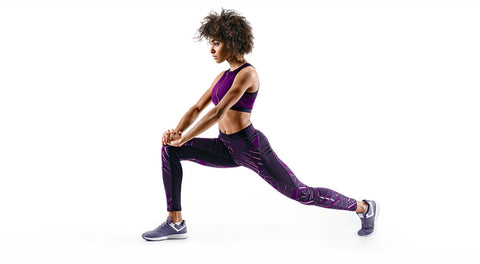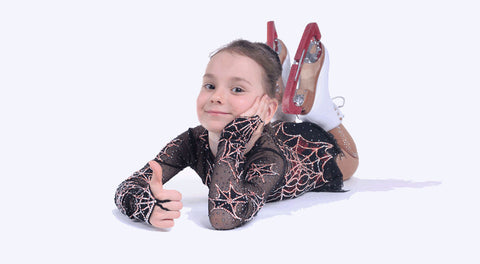A Comprehensive Guide to Off-Ice Figure Skating Training
Off-ice training is a crucial aspect of figure skating that should not be overlooked when considering your workout program as an amatuer or professional skater.
It is an essential part of a skater's overall training program that complements on-ice practice.
Create Your Own Off-Ice Training Program At Home With Polyglide Synthetic Ice
Off-ice training helps skaters to improve their overall athleticism, strength, balance, and flexibility, which can enhance their on-ice performance and conditioning.
Off-Ice Training Fundamentals
Off-ice training is a crucial part of figure skating and brings many advantages for any level of skater.
It helps keep them safe and prevents injuries when they're on the ice.
Skaters participating in off-ice training regularly reduce their chances of getting hurt during practice or competition.
Moreover, off-ice training is famous for its ability to enhance physical fitness by boosting cardiovascular endurance, muscular strength, and flexibility.
This is particularly important for figure skaters, who must be in top shape to successfully pull off their routines.
Another perk of off-ice training is that it can improve performance on the ice so try your best to make it a fun experience.
So, it's definitely worth considering for any serious figure skater out there.
Skaters participating in off-ice training programs can develop the necessary skills and strength to perform more complex jumps, spin positions, and footwork.
Off-ice training is a significant factor for figure skaters as it can greatly enhance their performance and assist them in achieving their objectives all the way up to the more complex triple jumps.
Plus, off-ice training allows skaters to mix things up with other activities to improve their fitness and "level-up" their degree in figure skating.
Consider yoga, Pilates, ballet, and dance as these can help build flexibility, balance, and core strength, all key to nailing those tricky moves on the ice.
And get this: off-ice training can also help with mental focus, essential for mastering those complex jumps and spins.
When skaters regularly engage in off-ice training, it builds mental toughness that helps them push through challenges and stay focused during practice and competition.
Off-ice training is necessary for figure skaters who want to stay injury-free, physically fit, and mentally sharp.
If you're serious about taking your ice skating to the next level, it's best to work with a qualified coach or trainer who has experience with figure skaters.
The coach or trainer should create a lesson or classes (ballet, rotation, core strength) that is tailored to the individual skater's needs and goals.
Off-ice training plays a crucial role in the development of figure skaters, as it can significantly improve their performance and aid in the achievement of their goals to advance through the levels of skating.
Strength Training for Figure Skaters
Strength training constitutes a vital component of off-ice training for competitive figure skaters, as it fosters the development of muscles that are essential for executing jumps, spins, and footwork on the ice.
Moreover, strength training classes or lessons can serve to mitigate the likelihood of injuries and enhance overall athletic performance and skating routine.
Importance of a Strength Training Program
- Muscle Development: Ice skating demands substantial muscle strength, primarily in the legs, core muscles, and upper body. Engaging in strength training aids in developing these muscles, thereby augmenting power and explosiveness on the ice.
- Injury Mitigation: The cultivation of robust muscles can help reduce injury risk, particularly in the knees, ankles, and hips, which are commonly susceptible areas for figure skaters.
- Improved Performance: Strong muscles allow figure skaters to execute more complex jumps, spins, and footwork, which can improve overall performance and scores.
Types of Strength Training and Conditioning
Many types of strength training exercises can be beneficial for figure skaters to improve their performance and skating skills.
Some of the most effective include:
- Plyometric Exercises: These are explosive power movements that help to build power and strength, such as box jumps, jump squats, and single-leg jumps.
- Bodyweight Exercises: These exercises use the body's own weight to build strength, such as push-ups, squats, and lunges.
- Weight Lifting: This involves using weights or resistance bands to build strength, such as bench presses, deadlifts, and bicep curls.
Body Form and Technique Exercises
Proper form and position are essential for effective and safe strength training.
Here are some tips for performing strength training exercises with proper form:
- Keep your core engaged in protecting your lower back.
- Use a full range of motion for each exercise.
- Use proper breathing techniques, exhaling on the exertion and inhaling on the release.
- Avoid overloading the weight, which can lead to injury.
Recommended Power Sets and Sample Routine
It is important to perform a sufficient number of sets and repetitions to get the most out of strength training,
Here is a recommended set and repetition range for figure skaters:
- Three sets of 8-12 reps for plyometric exercises
- Three sets of 12-15 reps for bodyweight exercises
- Three sets of 8-10 reps for weight lifting exercises
Here is a sample routine for figure skaters that incorporates strength training:
- Warm-up: 5-10 minutes of cardio (such as jogging or jumping jacks)
- Plyometric Exercises: Box jumps (3 sets of 8-12 reps), jump squats (3 sets of 8-12 reps), single leg jumps (3 sets of 8-12 reps on each leg)
- Bodyweight Exercises: Push-ups (3 sets of 12-15 reps), squats (3 sets of 12-15 reps), lunges (3 sets of 12-15 reps on each leg)
- Weight Lifting: Bench press (3 sets of 8-10 reps), deadlifts (3 sets of 8-10 reps), bicep curls (3 sets of 8-10 reps)
- Cool-down: 5-10 minutes of stretching
In summary, the incorporation of strength training exercises into off-ice training routines is a crucial aspect for figure skaters overall conditioning.
This training helps to cultivate muscles, prevent injuries, and elevate overall performance.
By undertaking strength training exercises in their off-ice training regimens, figure skaters can enhance their strength, power, and explosiveness when performing on the ice.
Flexibility Training for Figure Skaters and Athletes
Flexibility constitutes a fundamental element of figure skating, given that it allows skaters to execute a more extensive range of motion and perform more fluid movements.
Furthermore, flexibility plays a critical role in injury prevention, as taut muscles and joints can be predisposed to injuries.
Here are four tips on how figure skaters can improve their flexibility:
- Dynamic stretching: This type of stretching involves movement, such as leg swings or lunges, and is best done as part of a warm-up routine before ice skating or training to avoid injury (Be sure to stretch those hamstring muscles).
- Static stretching: This type of stretching involves holding a position for a set period of time, such as a seated straddle or hamstring stretch. It is best done after a workout or training session.
- Proprioceptive neuromuscular facilitation (PNF): This type of stretching involves a combination of contracting and relaxing the muscles being stretched. It is often done with a partner or a resistance band.
- Yoga: Many figure skaters incorporate yoga into their training routines, as it can improve flexibility, balance, and overall body awareness. Start easy before trying the more difficult positions.
When working on flexibility training, be sure to take it slow and expand the stretches a little at a time.
It's also essential to pay attention to proper form and technique to avoid injuries.
Here are a few additional tips:
- Breathe deeply and steadily throughout each stretch.
- Avoid bouncing or jerking movements, as these can strain muscles and joints.
- Hold each stretch for at least 15-30 seconds or longer if comfortable.
- Focus on major muscle groups such as the legs, hips, back, and shoulders.
By incorporating flexibility training into their routines, figure skaters can improve their performance on the ice, prevent injuries, and promote overall health and wellness.
Cardiovascular training is an essential component of figure skating, as it can improve endurance, stamina, and overall cardiovascular health.
Here are some tips on how figure skaters can improve their cardiovascular fitness:
- Aerobic exercise: This type of exercise involves continuous, rhythmic movements that elevate the heart rate and breathing rate, such as jogging, cycling, or slide board training.
- Interval training: This type of training involves rotating periods of high-intensity exercise with periods of lower intensity or rest. For example, a skater may sprint for 30 seconds, then walk or jog for a minute, and repeat for several rounds.
- Circuit training: This type of training involves moving through a series of exercises, such as jumping jacks, squats, lunges, and push-ups, with little to no rest in between. This can help improve both cardiovascular fitness and muscular endurance.
- Plyometrics: This type of training involves explosive movements, such as jump squats or box jumps, that can help improve power and speed.
When working on cardiovascular training, be sure to start slow until you can comfortably increase the intensity and duration of the exercises.
Here are a few additional tips:
- Choose activities that are enjoyable and varied to maintain motivation.
- Shoot for at least 30 minutes of moderate-intensity exercise most days of the week.
- Incorporate both aerobic and anaerobic exercises into your routine.
- Be sure to allow time to warm up and cool down before and after each session.
By incorporating cardiovascular training into their routines, figure skaters can improve their performance on the ice, boost their endurance and stamina, and promote overall health and fitness.
Injury Prevention and Nutrition
Injury prevention is a vital aspect of sports, and figure skating is no exception.
Outlined below are some injury prevention strategies that can aid in maintaining the health and safety of figure skaters:
- Proper warm-up and cool-down: A comprehensive warm-up regimen can facilitate the preparation of the body for physical activity by augmenting blood flow to the muscles and easing the joints. Cooling down after physical exertion can help prevent stiffness and diminish the likelihood of injuries. It is crucial to stretch all major muscle groups during both the warm-up and cool-down.
- Wear appropriate gear: Donning appropriate figure skating attire and equipment, such as well-fitted skates and protective padding, can help mitigate the risk of injuries.
- Cross-train: Cross-training with other activities, such as strength training, yoga, or swimming, can help improve overall fitness and reduce the risk of overuse injuries.
- Rest and recovery: Rest is crucial for allowing the body to recover and repair itself after exercise. Overtraining and pushing through pain can lead to injury and should be avoided.
- Proper technique: Proper technique is essential for preventing injury in figure skating. Coaches should emphasize correct form and technique for all jumps, spins, and other maneuvers, and skaters should not attempt moves beyond their skill level.
- Nutrition and hydration: A well-balanced diet and proper hydration can help support the body's ability to recover and repair itself after exercise, reducing the risk of injury.
By following these injury prevention strategies, figure skaters can reduce their risk of injury and stay healthy and active both on and off the ice.
It's important to work with a coach or trainer to develop a personalized training program that takes into account individual strengths, weaknesses, and injury history.
In addition, it's important to listen to the body and seek medical attention if pain or injury occurs.
Nutrition and Hydration for Figure Skaters
Proper nutrition and hydration are essential components of a figure skater's training regimen.
Proper fueling can help support energy levels, endurance, and recovery, while also reducing the risk of injury and illness.
Here are some tips for nutrition and hydration for figure skaters:
- Stay hydrated: It's important to drink enough water throughout the day to maintain proper hydration levels. During training, skaters should drink water before, during, and after their session to replenish fluids lost through sweat.
- Fuel up with carbohydrates: Carbohydrates are the body's primary source of energy, making them essential for figure skaters. Some great sources of carbohydrates include whole grains, fruits, and vegetables.
- Get enough protein: Protein is key for building and repairing muscles, and figure skaters require slightly more protein than sedentary individuals. Some great sources of protein you may want to consider include lean meats, fish, poultry, beans, and lentils.
- Choose healthy fats: Healthy fats, such as those found in nuts, seeds, avocados, and oily fish, can help provide sustained energy and support overall health.
- Don't forget about vitamins and minerals: A well-balanced diet that includes a variety of fruits and vegetables can help ensure that skaters get all the vitamins and minerals they need for optimal health and performance.
- Timing is key: It's important to fuel up before and after training sessions to ensure proper energy levels and recovery. Eating a small snack or meal containing carbohydrates and protein 30 minutes to an hour before training can help provide sustained energy, while eating a meal containing carbohydrates and protein within 30 minutes to an hour after training can help support muscle recovery.
- Avoid sugary and processed foods: Sugary and processed foods can provide quick energy but can also cause blood sugar spikes and crashes. Skaters should aim to limit their intake of these foods and instead choose whole, nutrient-dense options.
By following these nutrition and hydration tips, figure skaters can support their overall health and performance on and off the ice.
It's important to work with a registered dietitian or sports nutritionist to develop a personalized nutrition plan that takes into account individual needs and goals.
Mental Training Classes for Figure Skaters
Mental training is an essential component of a figure skater's overall training regimen.
The ability to stay focused, calm, and confident under pressure can make all the difference in a competition.
Here are some mental training strategies that figure skaters can use to improve their performance:
- Visualization: Visualization is a powerful mental tool that can help skaters improve their technique and performance. Skaters can visualize themselves executing a perfect jump, difficult spin, and landing positions, imagining the feeling of success and satisfaction.
- Positive self-talk: Self-talk is the internal dialogue that individuals have with themselves. By using positive self-talk, skaters can stay motivated and focused, even during challenging times. Positive self-talk involves replacing negative thoughts with positive affirmations, such as "I can do this" or "I am strong and capable."
- Goal-setting: Setting realistic, achievable goals can help skaters stay focused and motivated. By breaking down larger goals into smaller, more manageable ones, skaters can track their progress and see the results of their hard work.
- Breathing and relaxation techniques: Breathing and relaxation techniques can help skaters stay calm and focused during competition. Techniques such as deep breathing, progressive muscle relaxation, and meditation can help reduce anxiety and increase focus.
- Mental rehearsal: Mental rehearsal involves rehearsing a routine or performance in mind, using visualization techniques to imagine every detail. This technique can help skaters feel more prepared and confident when they step onto the ice.
- Positive imagery: Positive imagery involves using positive mental images to improve confidence and performance. Skaters can imagine themselves executing difficult elements flawlessly, feeling the satisfaction and pride that comes with success.
By incorporating these mental training strategies into their training regimen, figure skaters can improve their performance and ice skills both on and off the ice.
Also, consider stepping away to try something different like dance or ballet that will help you decompress away from the daily training grind.
It's important to work with a qualified sports psychologist or mental training coach to develop a personalized plan that takes into account individual needs and goals.
With a strong mental game, figure skaters can perform at their best and achieve their goals and skating skills.
Conclusion
n conclusion, off-ice training is a crucial component of a figure skater's training regimen.
Competitive Skaters can improve their performance both on and off the ice by incorporating a strength training program.
A skater will greatly improve their overall fitness and skills by implementing off-ice conditioning through:
- Flexibility training
- Cardiovascular training
- Injury prevention strategies
- Nutrition and hydration
- Mental training
That's not to say that beginners or recreational skaters would not also benefit to start training like a figure skater for better overall health.
Developing a personalized training plan that takes into account individual needs and goals, along with working with qualified coaches and trainers, is essential to achieving success in the sport of figure skating.
By displaying devotion, perseverance, and a comprehensive approach to training, figure skaters can fulfill their aspirations and experience their full potential in the sport they love.
So make the most of of your off-ice training program to maximize your full potential as a skater and athlete!






































